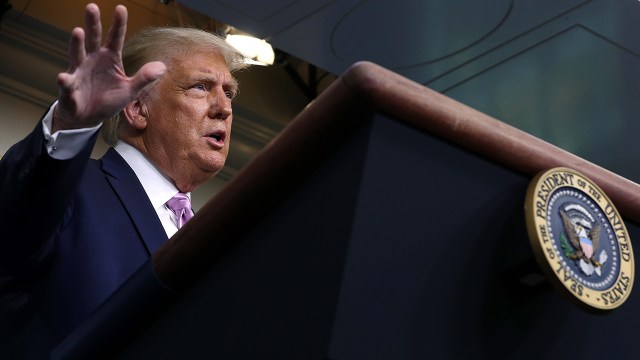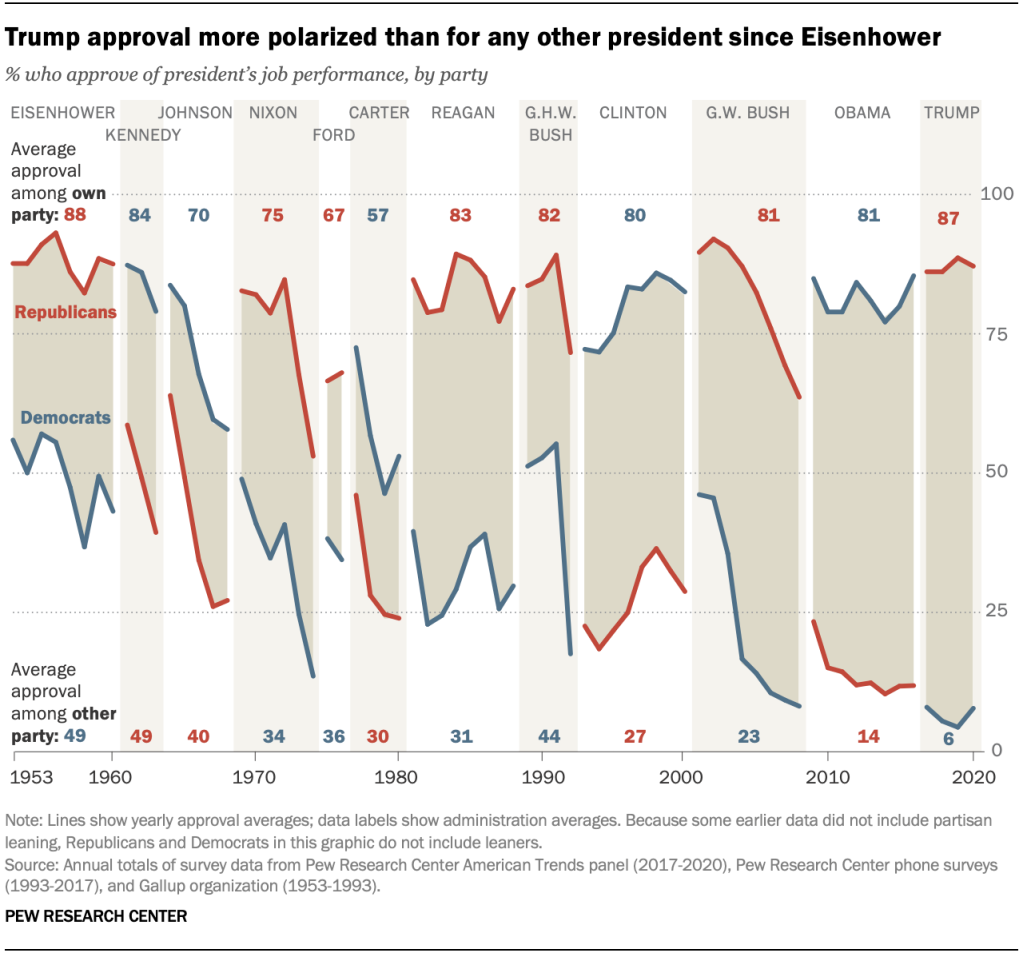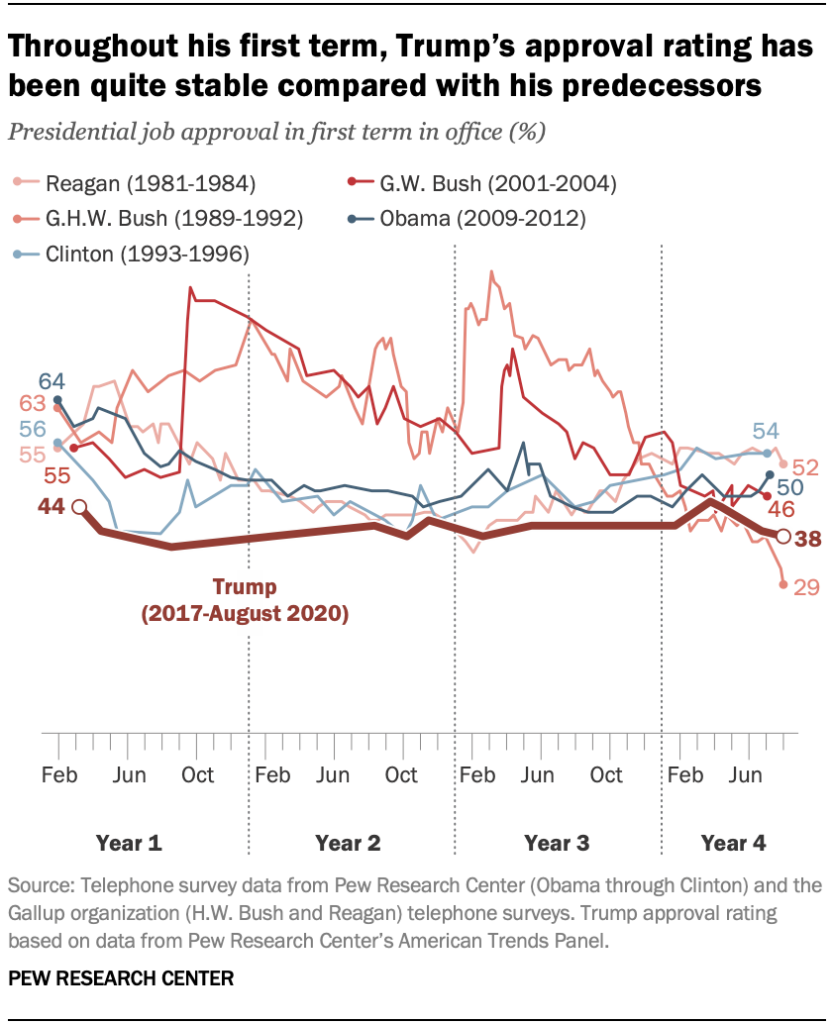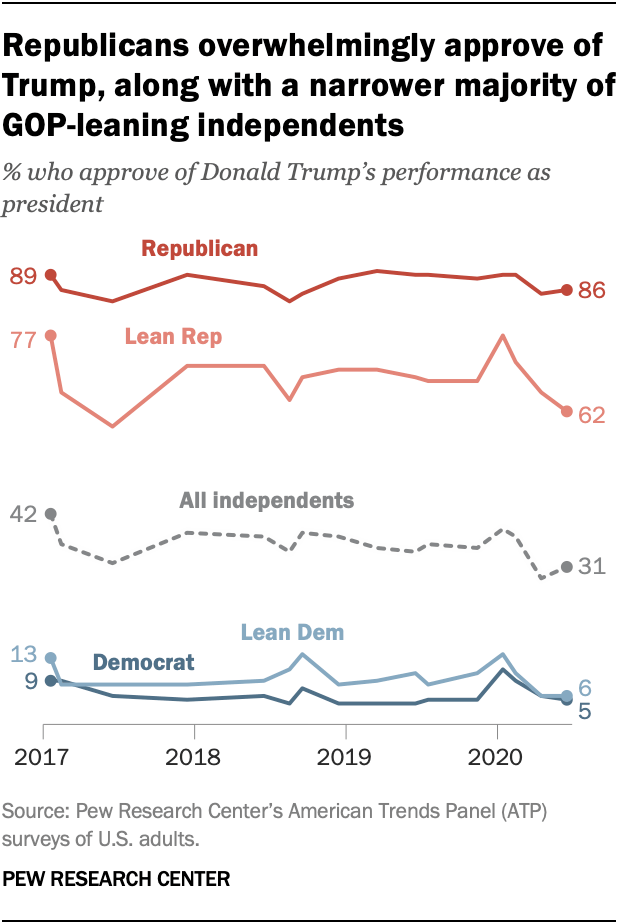
More than three and a half years into his administration, President Donald Trump’s approval ratings have remained remarkably stable. There also has been a wider gap between Republicans’ and Democrats’ views of Trump than for any other U.S. president in the modern era of polling.

About four-in-ten Americans (38%) approve of Trump’s job performance, while 59% disapprove, according to a recent Pew Research Center survey. Although Trump experienced a slight bump in approval ratings at the beginning of the coronavirus outbreak – 45% of the public in March and 44% of the public in April said they approved of the way Trump was handling his job – his approval ratings have settled back to where they were before the pandemic hit the United States.
Trump’s relatively steady ratings are unique among recent presidents. And while his ratings are also the most polarized along party lines in the modern era, this divide represents a continuation of a trend seen in assessments of recent presidents, including Barack Obama and George W. Bush.
Pew Research Center conducted this analysis to understand Donald Trump’s job approval ratings in a historical context. For this analysis, we looked at yearly averages for presidential job approval based on annual totals of Pew Research Center surveys from 1993 to 2020 and Gallup organization data from 1953 to 1993. Since 2017, Pew Research Center surveys on Trump’s job approval have been conducted on the Center’s nationally representative Americans Trends Panel (read more about the ATP’s methodology); surveys conducted between 1993 and 2017 (and earlier Gallup surveys) were conducted by telephone.
Over the course of his presidency to date, an average of 87% of Republicans have approved of Trump’s handling of the job, compared with an average of just 6% of Democrats. This 81-percentage-point gap is far larger than the partisan division in average ratings for Obama (67 points) and Bush (58 points) during their presidencies. (These growing partisan divides are consistent with widening divides in views of members of the opposing party, and with deep partisan divisions on political values, many of which are far more pronounced than in past decades.)
The growing partisan gap in assessments of U.S. presidents has been driven primarily by more negative ratings among members of the party that’s out of the White House. The 6% of Democrats who approve of Trump is lower than the 14% of Republicans who approved of Obama and the 23% of Democrats who approved of Bush during their respective administrations. Out-party ratings of the president were even higher in previous decades: For example, an average of 31% of Democrats approved of Ronald Reagan’s job performance.
Trump’s first-term approval ratings are lower than those of several recent presidents
Looking at individual surveys, Trump’s ratings stand out for their stability.
While Trump’s ratings today are about the same as they have been throughout his years in office (his rating has consistently fallen between 38% and 45% and hovered around 40% for much of his term), other presidents’ ratings saw far more change.
Obama’s initial approval rating of 64% dropped off in the first few months and largely remained in the mid to high 40s for much of his first term. Obama’s approval rating peaked at 56% in May 2011 – immediately following the killing of Osama Bin Laden – and sat at 50% in the summer of 2012.
George W. Bush’s approval ratings moved sharply higher in September of his first year – they reached 86% in the wake of the 9/11 terrorist attacks – before steadily declining to 46% in July 2004.
Approval ratings for Bill Clinton and Reagan moved lower during their first two years in office. But their ratings had rebounded by the summer preceding their reelection, with slightly more than half of Americans approving of each president’s performance.
George H.W. Bush’s ratings were particularly volatile. They improved in his first year before turning lower and then rising again to a high of 89% following the end of the Gulf War in 1991. Then they steadily fell to just 29% in the summer before his loss to Clinton in the 1992 election.
Trump’s job approval rating at this point in his presidency is lower than that of all of his recent predecessors except George H.W. Bush. The 38% of Americans who approve of Trump’s performance today compares with 29% for Bush in 1992. However, the two presidents’ disapproval rating is similar: 58% disapprove of Trump’s performance today, compared with 60% for Bush in 1992.
Trump’s approval rating is broadly positive among independents who say they lean toward the Republican Party, though not quite as high as among self-identified Republicans. As of August 2020, 62% of GOP leaners say they approve of the way Trump is handling his job in office, compared with 86% of Republican identifiers.
By contrast, just 5% of Democrats and a nearly identical share of Democratic leaners (6%) currently approve of how Trump his handling his job in office.
Note: This is an update of a post originally published on Aug. 1, 2018.


